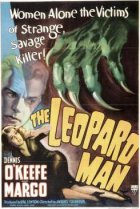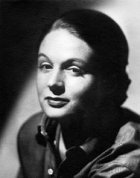
The Leopard Man Page #13
- APPROVED
- Year:
- 1943
- 66 min
- 467 Views
Galbraith's workshop is completely practical. A trestle table
with an office armchair behind it, book shelves and transfer
cases containing labeled shards and artifacts are in this
alcove. On the trestle table, which Galbraith uses as a desk,
is a reading glass on a fixed stand which he uses to examine
specimens.
Charlie and Jerry walk in. Charlie has evidently been here
before because he shuffles down the main aisle through the
display room without looking around. Jerry keeps pace with
him but glances from side to side at various pieces. At the
end of the museum they turn and enter the little alcove where
Galbraith is seated at his desk. He is sharpening a pencil
and does not look up. They wait.
GALBRAITH:
(looking up)
Why, hello.
He gets up, comes around the table.
JERRY:
You know Charlie How-Come?
GALBRAITH:
We're old friends.
Charlie nods.
GALBRAITH:
(to Jerry)
Come to look around?
JERRY:
More or less.
GALBRAITH:
I'll take you about. Got some nice
things.
He starts off and they follow him.
JERRY:
(as they walk)
Charlie and I were talking. That's
one reason I wanted to see you.
GALBRAITH:
(looks at him)
About Charlie's leopard?
JERRY:
Yes.
They have reached the display room and pause a moment. From
this point on, the CAMERA TRUCKS WITH them as they go.
Galbraith acts as cicerone, conducting them about, walking
ahead of them as he displays the exhibits.
GALBRAITH:
(pointing)
Here is something that should
interest Charlie - a stone leopard
head made by his ancestors some six
hundred years ago. They used it in
ceremonies. The jaguar -- in fact
all the cat family -- were
considered the personification of
force and violence in their
religious rites.
CHARLIE:
(squinting at it)
It don't look like a leopard to me.
They walk on. Jerry has paid no attention to the exhibit.
JERRY:
Charlie doesn't think the leopard
killed the girl in the cemetery.
GALBRAITH:
(turning, with a smile)
Charlie likes his leopard.
CHARLIE:
Sure, I like my leopards
JERRY:
But he admitted quick enough that
it killed the first girl.
GALBRAITH:
(patiently)
Well, Charlie, just why do you
think your cat didn't kill the
Contreras girl?
CHARLIE:
You know -- not scared enough.
Nothing to scare it.
GALBRAITH:
If a leopard didn't do it, who did?
JERRY:
It could be a man.
GALBRAITH:
It could be. Why would a man kill
her? For what? It wasn't robbery.
It wasn't a crime of jealousy or
passion. She had no enemies.
Charlie shrugs.
JERRY:
There are all sorts of men. You get
to see some funny ones as a
reporter.
GALBRAITH:
(sagely)
I can understand what you mean -
demented men, pathological cases.
But what sort of man would kill
like a leopard and leave the traces
of a leopard?
JERRY:
Some crazy guy.
GALBRAITH:
But he would have to know about
leopards - have access to leopard
claws and hair.
They walk on. Galbraith points out a nicely molded jug.
GALBRAITH:
Here's our prize exhibit - an
artifact of the Paleolithic period.
He looks into the case with a glance almost of affection,
then turns back to Jerry.
GALBRAITH:
certain barrow. I went back and I
tried again. I just had a hunch.
JERRY:
(thoughtfully)
A hunch -- that's all I've got
about this leopard thing. It's just
a hunch, yet I feel it deep in the
stomach. It was a man!
GALBRAITH:
Yes, but what sort of a man?
JERRY:
I don't know.
GALBRAITH:
(turning toward Charlie
chuckling)
You, Charlie -- you know leopards.
You might have had an old claw
around somewhere, and perhaps a bit
of hair from the cage -� eh?
CHARLIE:
(seeing the joke, with a
wide grin)
Sure!
JERRY:
No. I'm serious about this.
GALBRAITH:
(still smiling)
Oh, I'm only exploring your theory.
Let's take a step further. You
drink, don't you, Charlie?
CHARLIE:
I drink.
GALBRAITH:
And when you drink, you get drunk.
Charlie nods.
GALBRAITH:
Then what do you do?
CHARLIE:
I sleep it off.
GALBRAITH:
But between the time you leave the
cant ma and fall into bed in that
old truck of yours, what happens,
Charlie?
CHARLIE:
I don't know.
GALBRAITH:
(stopping near the door)
That's just it, Charlie. That's
what I'm driving at. You could do
anything in that time.
JERRY:
Charlie wasn't drunk last night.
CHARLIE:
(very worried)
Yes, I was drunk, Mr. Manning.
Galbraith makes a gesture with his arms as if to say "There
you are." Charlie shakes his head.
GALBRAITH:
(with a wide friendly
smile)
See? There's a suspect for you,
Jerry.
Jerry looks over at Charlie, who is very woebegone, worried
and nervous.
JERRY:
(taking his arm, kidding)
Come on, Charlie. Let's go find
another and better suspect.
GALBRAITH:
Don't you want to see the rest of
the exhibit?
JERRY:
Some other time.
The men nod to each other. Jerry leads Charlie out.
EXT. MUSEUM PORTICO - DAY
Charlie and Jerry come out of the museum and stand for a
moment on the edge of the steps. Behind there the Indian
woman continues working at her loom, the heavy shuttle goes
back and forth.
CHARLIE:
I'm sick.
JERRY:
(reaching into his pocket)
Here have a cigarette. He was only
kidding.
CHARLIE:
No, he wasn't kidding. I'm sick.
Claw women? Hurt little girls? No!
Jerry is still holding the cigarette out toward him.
CHARLIE:
I don't know. I want to see Robles.
JERRY:
What do you want to see him for?
CHARLIE:
I want him to lock me up.
JERRY:
Look, Charlie, you didn't do it,
and you know you didn't.
CHARLIE:
I don't know. I want him to lock me
up.
He starts forward and Jerry goes with him.
DISSOLVE:
EXT. ENTRANCE TO THE ALLEY - DAY
Charlie's truck is parked at one corner. He, Jerry and Robles
stand in front of it talking.
CHARLIE:
The Doc's right. I don't know what
I do when I get drunk. I don't
know.
ROBLES:
This is crazy, Charlie. You know
you didn't do it.
CHARLIE:
You'd better lock me up.
JERRY:
I've been trying to tell him,
Sheriff. He won't listen to me.
ROBLES:
Let me get one thing clear. Did
Galbraith make a direct accusation?
JERRY:
No. He was kidding Charlie.
CHARLIE:
You'd better lock me up. If I do
things like that I want to be put
away. I don't want to hurt nobody.
ROBLES:
(takes his arm)
All right, Charlie. If it will
relieve your mind, I'll put you
away for a few days.
DISSOLVE:
INT. JAIL - NIGHT
MED. CLOSE SHOT -Charlie holding on to some cell bars, stands
brooding. O.S., we hear the sound of castanets. Charlie lifts
his head to look out of an unseen window.
EXT. STREET - NIGHT
TRUCKING SHOT - Clo-Clo, dressed in dancing costume, with a
black shawl over it, passes along the street, clicking her
castanets idly. From afar we hear a sad, sweet Mexican love
song, being sung in a high tenor voice.
Clo-Clo passes a dimly lit doorway, and we see a woman
sprinkling holy water on the door step from a font that hangs
beside the door.
MEXICAN WOMAN:
Valganos Dios.
She makes the sign of the cross and softly closes the door.
Further down the street, two policemen pass Clo�Clo, walking
in step. She grins at them.
Translation
Translate and read this script in other languages:
Select another language:
- - Select -
- 简体中文 (Chinese - Simplified)
- 繁體中文 (Chinese - Traditional)
- Español (Spanish)
- Esperanto (Esperanto)
- 日本語 (Japanese)
- Português (Portuguese)
- Deutsch (German)
- العربية (Arabic)
- Français (French)
- Русский (Russian)
- ಕನ್ನಡ (Kannada)
- 한국어 (Korean)
- עברית (Hebrew)
- Gaeilge (Irish)
- Українська (Ukrainian)
- اردو (Urdu)
- Magyar (Hungarian)
- मानक हिन्दी (Hindi)
- Indonesia (Indonesian)
- Italiano (Italian)
- தமிழ் (Tamil)
- Türkçe (Turkish)
- తెలుగు (Telugu)
- ภาษาไทย (Thai)
- Tiếng Việt (Vietnamese)
- Čeština (Czech)
- Polski (Polish)
- Bahasa Indonesia (Indonesian)
- Românește (Romanian)
- Nederlands (Dutch)
- Ελληνικά (Greek)
- Latinum (Latin)
- Svenska (Swedish)
- Dansk (Danish)
- Suomi (Finnish)
- فارسی (Persian)
- ייִדיש (Yiddish)
- հայերեն (Armenian)
- Norsk (Norwegian)
- English (English)
Citation
Use the citation below to add this screenplay to your bibliography:
Style:MLAChicagoAPA
"The Leopard Man" Scripts.com. STANDS4 LLC, 2025. Web. 3 Mar. 2025. <https://www.scripts.com/script/the_leopard_man_896>.







Discuss this script with the community:
Report Comment
We're doing our best to make sure our content is useful, accurate and safe.
If by any chance you spot an inappropriate comment while navigating through our website please use this form to let us know, and we'll take care of it shortly.
Attachment
You need to be logged in to favorite.
Log In